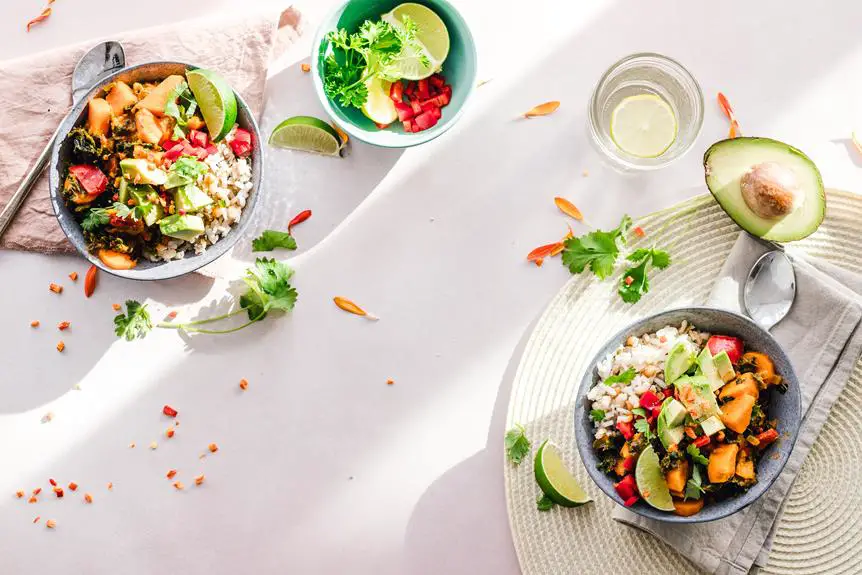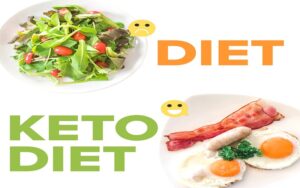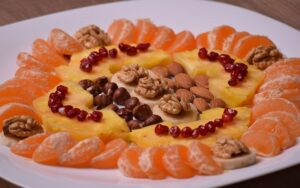The keto diet has become increasingly popular for its potential weight loss benefits and overall health improvements.
However, it is crucial to be aware of certain foods that can hinder your progress towards ketosis, the state where your body burns fat for fuel.
In this article, we will examine 15 foods that should be avoided on a keto diet.
By understanding and avoiding these potential pitfalls, you can navigate the keto diet with confidence and increase your chances of success. If want faster result you can try with custom keto plan that we recommend.
Refined Carbs
Within the context of the knowledge surrounding the keto diet, it is crucial to be aware of the detrimental effects of consuming refined carbs.
Refined carbs, such as white bread, cooked white pasta, cooked white rice, and white flour tortillas, are high in carbohydrates and low in fiber. These foods can cause blood sugar spikes and disrupt ketosis, hindering the body’s ability to burn fat for energy.
Additionally, refined carbs lack essential nutrients and can contribute to weight gain and increased risk of chronic diseases. To maintain ketosis and support overall health, it is recommended to substitute refined carbs with alternatives like mashed or riced cauliflower or low-carb bread options.
Understanding the impact of refined carbs is fundamental in achieving success with the keto diet.
Keto diet: Avoid Beer and Mixed Drinks
While beer and mixed drinks may be enjoyable to consume, they pose a significant danger to the success of the keto diet due to their high carbohydrate content and low nutrient value. Here are three reasons why beer and mixed drinks should be avoided on a keto diet:
- High carb and low nutrient count: Beer and mixed drinks are typically high in carbohydrates and offer little to no nutritional value, making them unsuitable for a keto diet.
- Little research on alcohol’s effects on the liver while on keto: There is limited scientific research on how alcohol consumption affects the liver when following a keto diet, so it’s best to err on the side of caution and avoid excessive alcohol intake.
- Be cautious of carb content in alcoholic beverages: Alcoholic beverages can contain varying amounts of carbohydrates, and some mixed drinks can be particularly high in sugar. It’s important to carefully consider the carb content of these drinks and opt for low-carb alternatives whenever possible.
Honey and Syrups
Honey and syrups should be strictly avoided on a keto diet due to their concentrated sugar content and minimal nutritional value. Honey, for instance, contains 17 grams of carbs per tablespoon, while maple syrup contains 13 grams of carbs per tablespoon. Consuming these sweeteners can lead to blood sugar spikes and disrupt ketosis, the metabolic state necessary for the keto diet to be effective.
Since the keto diet focuses on low carbohydrate intake, it is crucial to steer clear of high-sugar foods like honey and syrups. Instead, individuals following a keto diet can opt for natural sweeteners like stevia or erythritol, which have minimal impact on blood sugar levels and ketosis.
Juice
Furthermore, juice, although often perceived as a healthy beverage, can be detrimental to a keto diet due to its high content of naturally occurring sugar and lack of dietary fiber. Here are three reasons why juice should be avoided:
- High sugar content: Juice is typically high in naturally occurring sugars, which can quickly spike blood sugar levels and disrupt ketosis.
- Lack of dietary fiber: Juice lacks the dietary fiber needed for proper digestion and blood sugar control. Without fiber, the sugar in juice is absorbed more rapidly, leading to unstable blood sugar levels.
- Avoid high carb, low fiber juices: Fruit juices like orange, apple, and grape are high in carbs and low in fiber, making them unsuitable for a keto diet.
To stay in ketosis, it is best to avoid juice and opt for water or unsweetened beverages instead.
Sugary Sodas
One can of sugary soda contains 39g of carbs, making it a high-carb beverage to be avoided on a keto diet. Sugary sodas provide zero nutrition and have a high carb count, which can disrupt ketosis. These beverages lack essential nutrients and are typically loaded with added sugars.
Consuming sugary sodas can lead to blood sugar spikes and hinder progress on a keto diet. It is advisable to opt for sugar-free sodas or infused water alternatives instead. These alternatives can provide a more refreshing and hydrating option without the negative effects of high sugar content.
Sticking to a low-carb and sugar-free beverage choice is essential for maintaining ketosis and achieving the desired results on a keto diet.
Condiments
When following a keto diet, it is important to be cautious of condiments that are often sugar-packed, such as ketchup, barbecue sauce, and sweet chili sauce. These condiments can contain a significant amount of carbohydrates, which can hinder ketosis and lead to blood sugar spikes.
To maintain a keto-friendly eating plan, consider the following tips for condiments:
- Opt for vinegar-based sauces or fat-rich condiments like mayonnaise instead of ketchup, barbecue sauce, and sweet chili sauce.
- Read nutrition labels carefully to check the carbohydrate content of condiments.
- Consider making homemade versions of condiments using low-carb ingredients to have better control over the sugar content.
Glazed or Honey-Baked Ham
Avoid consuming glazed or honey-baked ham as it contains sugar that is baked onto or infused into the hams, which can disrupt ketosis and hinder progress on a keto diet.
Glazed or honey-baked hams are typically prepared with sweeteners like brown sugar, maple syrup, or honey, which contribute to their sweet flavor. These sugars can cause blood sugar spikes and kick you out of ketosis, the metabolic state where your body burns fat for fuel instead of carbohydrates.
If you wish to include ham in your keto diet, choose regular deli ham that contains less than 1g of carbs per slice and does not have added sweeteners. It is important to read labels carefully to make informed choices and maintain ketosis while following a keto diet.
Light or Low-Fat Margarine
Occasionally, light or low-fat margarine can be a tempting option for those following a keto diet, but it is important to be cautious of its low fat content. Here are some key points to consider:
- Low fat: Light margarine is specifically designed to have a lower fat content compared to regular margarine and butter.
- Essential fat: Fat is an essential macronutrient in a keto diet as it helps promote ketosis and provides energy.
- Alternatives: Opt for unsalted butter or moderate servings of regular margarine, which contain higher fat content.
- Read labels: Check the nutrition labels to ensure that the chosen margarine fits within the desired macronutrient ratios for the keto diet.
It is crucial to prioritize healthy fats in a keto diet, making it necessary to choose margarine options that align with the diet’s principles.
Dried Fruit or Trail Mix
The keto diet’s principles entail avoiding dried fruit or trail mix due to their high sugar content and potential to disrupt ketosis. Drying fruit concentrates its sugar content, making it a poor choice for those following a low-carb, high-fat diet. For example, a Medjool date contains 18g of carbs and only 2g of fiber. Mixed dried fruit can have as much as 31g of carbs per 1/4 cup.
Instead, individuals on the keto diet should opt for fresh berries, which are lower in sugar and higher in fiber. It is important to remember that the keto diet aims to minimize carbohydrate intake to achieve and maintain a state of ketosis, where the body burns fat for fuel instead of carbohydrates.
Low-Fat Diet Foods
When following a keto diet, it is important to be cautious of low-fat diet foods. While these foods may seem like a healthy choice, they can actually hinder your progress on a ketogenic diet. Here are three reasons to avoid low-fat diet foods:
- Higher sugar content: Low-fat foods often compensate for the lack of fat by adding more sugar. This can lead to blood sugar spikes and disrupt ketosis, the metabolic state necessary for the keto diet.
- Reduced nutrient absorption: Fat helps with the absorption of fat-soluble vitamins like A, D, E, and K. By opting for low-fat foods, you may be missing out on these important nutrients.
- Decreased satiety: Fat provides a feeling of fullness and helps to control hunger. By choosing low-fat foods, you may find yourself feeling hungry more often, leading to overeating and difficulty sticking to your keto diet goals.
It is crucial to read nutrition labels carefully and choose whole, high-fat foods instead of low-fat alternatives when following a keto diet.
Potatoes
Avoid potatoes as they are high in carbs and can hinder ketosis, which is essential for a successful keto diet. Potatoes, whether white or sweet, are starchy vegetables that contain a significant amount of carbohydrates. A medium-sized white potato, for example, can provide around 37 grams of carbs. This can quickly exceed the daily carb limit allowed on a keto diet.
Consuming potatoes can cause blood sugar spikes and disrupt the metabolic state of ketosis, where the body burns fat for fuel instead of carbohydrates. It is best to avoid potatoes and opt for low-carb alternatives like cauliflower or zucchini as substitutes.
Certain Fruits
Limit or exclude bananas, grapes, mangoes, and other high-sugar fruits from your keto diet. These fruits can derail your efforts to stay in ketosis due to their high carbohydrate content. Here are three reasons why you should avoid these fruits:
- High in carbs: Fruits like bananas, grapes, and mangoes are packed with natural sugars, which can cause a spike in your blood sugar levels and hinder your ability to reach and maintain ketosis.
- Lack of fiber: These high-sugar fruits are also low in dietary fiber, which is essential for digestion and blood sugar control. Without enough fiber, you may experience digestive issues and difficulty managing your blood sugar levels.
- Alternatives available: Instead of these high-sugar fruits, consider opting for low-carb options such as berries, which are lower in sugar and higher in fiber. These fruits can still provide you with essential vitamins and minerals while keeping your carb intake in check.
Processed Snacks
While it may be tempting to indulge in processed snacks, it is important to be aware that these snacks are typically high in carbs and can disrupt your keto diet.
Processed snacks such as chips, crackers, and cookies often contain refined grains, added sugars, and unhealthy fats, which can spike your blood sugar levels and kick you out of ketosis.
These snacks are also low in essential nutrients and fiber, leaving you feeling unsatisfied and craving more.
Instead of reaching for processed snacks, opt for homemade keto-friendly alternatives like kale chips, cheese crisps, or roasted nuts.
These options provide healthier fats and fewer carbs, helping you stay on track with your keto diet goals.
High-Sugar Desserts
Indulging in high-sugar desserts can sabotage your keto diet as they are typically loaded with sugar and carbs, undermining your efforts to maintain ketosis. Here are some reasons why you should avoid high-sugar desserts:
- High sugar content: High-sugar desserts, such as cakes, cookies, and ice cream, contain a significant amount of sugar, which can cause blood sugar spikes and hinder ketosis.
- High carb content: These desserts are also packed with carbs, which can kick you out of ketosis and prevent your body from burning fat for fuel.
- Lack of nutritional value: High-sugar desserts offer little to no nutritional value, providing empty calories that can derail your diet goals.
To stay on track with your keto diet, consider exploring keto-friendly dessert recipes that use low-carb sweeteners as a healthier alternative to satisfy your sweet tooth.
High-Carb Sauces and Dressings
Avoiding high-carb sauces and dressings is crucial for maintaining a ketogenic diet. Many popular sauces and dressings, such as teriyaki, honey mustard, and balsamic vinaigrette, can be high in carbohydrates, which can hinder ketosis and lead to an increase in blood sugar levels.
It is important to opt for homemade or low-carb alternatives to ensure that your meals remain keto-friendly. Making your own sauces and dressings allows you to control the ingredients and limit the amount of carbs added. Additionally, there are various low-carb options available in stores that can be used as substitutes.
Find more tips on our health section




